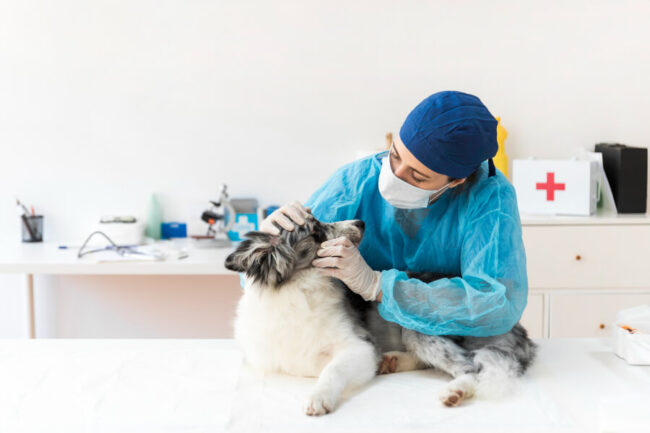If you’re a pet owner, you know the importance of keeping your furry friends healthy and happy.
One of the less pleasant challenges you might face is scabies, also known as sarcoptic mange.
This condition, while treatable, can cause significant discomfort for your pets. In this blog, we’ll dive into everything you need to know about Pet scabies—what it is, how to spot it, and, most importantly, how to treat it with home remedies and prevent it in the future. Let’s get started!
What is Scabies (Sarcoptic Mange) on Pets?
Pet scabies is a highly contagious skin condition caused by the Sarcoptes scabiei mite. These microscopic mites burrow into the skin of pets, causing intense itching and irritation. Though commonly associated with dogs, scabies can also affect cats and other animals.
The condition is known for its rapid spread, especially in environments where multiple animals are in close contact. Pet owners often find themselves dealing with outbreaks in shelters, kennels, and multi-pet households. Understanding the nature of pet scabies is the first step towards effective management and treatment.
What are the Symptoms of Scabies on Pets?
Identifying scabies early can make a significant difference in the treatment and recovery process. Here are some common symptoms to watch out for:
- Intense Itching: One of the hallmark signs of scabies is relentless itching. Your pet may scratch, bite, or lick their skin excessively.
- Redness and Rash: Inflamed, red patches of skin are common, often accompanied by a rash.
- Hair Loss: Due to constant scratching and irritation, pets often lose fur in the affected areas.
- Crusty or Scaly Skin: The skin might develop a crusty or scaly texture, sometimes with sores or blisters.
- Restlessness and Discomfort: Affected pets may become restless or exhibit changes in behavior due to the constant discomfort.
If you notice these symptoms, it’s crucial to act quickly to prevent the condition from worsening and to avoid spreading it to other pets or humans.
How are Scabies Diagnosed in Pets?
Diagnosing pet scabies typically involves a visit to the veterinarian. The vet will perform a physical examination and may take a skin scraping to look for mites under a microscope. Here’s what you can expect:
- Physical Examination: The vet will check your pet’s skin for signs of irritation, redness, and hair loss.
- Skin Scraping: A small sample of the affected skin is scraped off and examined under a microscope to confirm the presence of mites.
- Medical History: Your vet might ask about your pet’s medical history and any recent exposure to other animals to help with diagnosis.
While a vet’s diagnosis is crucial, understanding the symptoms and being vigilant can help you catch the condition early and seek prompt treatment.
Are There Differences in pet scabies for Dogs and Cats?
Yes, while the Sarcoptes scabiei mite can affect both dogs and cats, there are some differences in how the condition manifests and is treated in these animals.
In Dogs:
- Symptoms: Dogs typically show intense itching, redness, and hair loss, especially around the ears, elbows, and abdomen.
- Treatment: Treatment often involves medicated baths, topical treatments, and sometimes oral medications prescribed by a vet.
In Cats:
- Symptoms: Cats may also exhibit itching and hair loss, but the condition can sometimes be more challenging to diagnose due to their grooming habits, which might hide some symptoms.
- Treatment: Treatment for cats might include topical medications and ensuring the living environment is thoroughly cleaned to prevent re-infestation.
Understanding these differences can help tailor your approach to treating and managing different pet scabies.
How Do You Treat Canine Scabies?
Treating scabies in dogs involves a combination of veterinary care and home remedies to alleviate symptoms and eradicate the mites. Here’s a step-by-step guide:
1. Veterinary Treatment
- Medications: Vets commonly prescribe medications such as ivermectin, selamectin, or milbemycin. These can be given orally or as topical treatments.
- Medicated Baths: Regular baths with medicated shampoos containing ingredients like sulfur or benzoyl peroxide can help soothe the skin and kill mites.
- Topical Treatments: Products containing permethrin or lime sulfur dips can be effective.
2. Home Remedies
- Apple Cider Vinegar: Dilute apple cider vinegar with water and spray it on your dog’s skin to help reduce itching and kill mites.
- Coconut Oil: Applying coconut oil can soothe irritated skin and has antimicrobial properties.
- Aloe Vera: Pure aloe vera gel can provide relief from itching and promote healing.
- Tea Tree Oil: While potent, tea tree oil should be used with caution and always diluted, as it can be toxic in large amounts. A few drops mixed with water can be applied to affected areas.
3. Environmental Management
- Cleaning: Regularly clean and disinfect your pet’s bedding, toys, and living areas to prevent re-infestation.
- Isolation: Keep the affected pet isolated from other animals until the condition is fully treated to prevent spreading.
Combining veterinary care with home remedies can provide relief for your dog and help ensure a full recovery.
Can Humans Get Scabies?
Yes, humans can contract scabies from pets, but it’s a different mite known as Sarcoptes scabiei var. hominis. While pet scabies mites can cause temporary itching and discomfort in humans, they cannot reproduce on human skin and typically die off quickly.
Symptoms in Humans
- Itching: Intense itching, especially at night.
- Rash: Small, red bumps or blisters.
- Burrows: Thin, irregular tracks on the skin, caused by mites burrowing.
If you suspect you’ve contracted scabies from your pet, consult a healthcare provider for appropriate treatment, which may include topical medications to eliminate the mites.
How Can I Prevent Mange and Scabies for My Pets?
Prevention is always better than cure. Here are some tips to keep your pets safe from mange and pet scabies:
1. Regular Check-ups
- Vet Visits: Regular veterinary check-ups can help detect early signs of mange.
- Grooming: Routine grooming and bathing keep your pet’s skin healthy and can help spot early symptoms.
2. Hygiene
- Clean Living Area: Regularly clean and disinfect your pet’s bedding, toys, and living spaces.
- Wash Hands: After handling your pet, wash your hands thoroughly to prevent the spread of mites.
3. Avoid Exposure
- Limit Contact: Avoid letting your pet interact with animals known to have pet scabies.
- Isolation: If you have multiple pets, isolate any that show symptoms until they are treated.
4. Healthy Diet
- Nutrition: A balanced diet keeps your pet’s immune system strong, making them less susceptible to infections.
- Supplements: Consider supplements like omega-3 fatty acids to promote healthy skin.
By taking these preventive measures, you can reduce the risk of mange and keep your pets healthy and happy.
Conclusion
Dealing with Pets scabies can be a challenging and stressful experience, but with the right knowledge and approach, you can effectively manage and treat this condition. By understanding the symptoms, seeking prompt veterinary care, and utilizing home remedies, you can provide relief for your furry friends and prevent future outbreaks.
Remember, prevention is key. Regular vet check-ups, good hygiene practices, and a healthy lifestyle for your pets can go a long way in keeping pet scabies and other health issues at bay. Your pets depend on you for their well-being, and with the right care, you can ensure they stay happy, healthy, and itch-free.
FAQs
How Severe Can Scabies Be For My Pets?
Pet scabies can range from mild to severe. If left untreated, it can lead to secondary infections, severe skin damage, and significant discomfort for your pet. Early detection and treatment are crucial to prevent complications.
From Where Do My Pets Get Scabies?
Pets can contract scabies through direct contact with an infected animal or by sharing contaminated bedding, grooming tools, or other items. Environments with high animal populations, such as shelters and kennels, are common sources.
What Is The Duration Of Scabies In Pets?
The duration of Pet scabies depends on the severity of the infestation and how quickly treatment is administered. With prompt and effective treatment, symptoms can improve within a few weeks, but full recovery may take several months. Consistent treatment and environmental cleaning are essential to prevent re-infestation.







